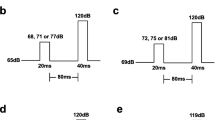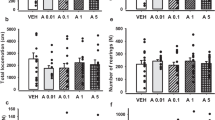Abstract
Rationale
DBA/2 mice demonstrate poor prepulse inhibition (PPI) as is also observed in schizophrenic patients, and their PPI is improved by antipsychotics. Thus, the DBA/2 mouse is increasingly used for testing of novel antipsychotics in PPI; however, the strain has not been fully characterized for relevant variables affecting compound testing.
Objectives
The objectives of this study were to compare four DBA/2 substrains, evaluate light- and dark-phase testing on startle, PPI, and drug-induced improvement in PPI in DBA/2NCrl mice, test chamber lighting on startle and PPI in DBA/2NCrl mice and to evaluate vehicles on baseline PPI in DBA/2NCrl mice.
Results
DBA/2NCrl and DBA/2J mice were acceptable for PPI testing, while DBA/2NHsd mice had diminished startle reflexes. Startle responses to the prepulses alone were observed in 46% of the DBA/2NTac mice. PPI and startle did not show diurnal variations or variations due to chamber lighting. Olanzapine and aripiprazole showed better drug-induced improvements in PPI during the light phase. The vehicle 25% (2-hydroxypropyl)-β-cyclodextrin variably improved PPI, an effect not observed with other vehicles.
Conclusions
DBA/2NHsd and DBA/2NTac mice were unacceptable for PPI experiments. The finding of responses to the prepulses alone by DBA/2NTac mice further indicates the advisability of routinely monitoring responses to prepulses alone. Unlike rats, DBA/2NCrl mice did not have greater startle amplitudes during the dark phase. Compound efficacy was better during the light phase because of poorer PPI in the vehicle group. Some vehicles may have unacceptable effects on PPI in DBA/2NCrl mice and may not be appropriate for studies evaluating novel compounds.





Similar content being viewed by others
References
Abulrob A, Tauskela JS, Mealing G, Brunette E, Faid K, Stanimirovic D (2005) Protection by cholesterol-extracting cyclodextrins: a role for N-methyl-d-aspartate receptor redistribution. J Neurochem 92:1477–1486
Braff DL, Geyer MA, Swerdlow NR (2001) Human studies of prepulse inhibition of startle: normal subjects, patient groups, and pharmacological studies. Psychopharmacology 156:234–258
Brooks SP, Pask T, Jones, Dunnett SB (2004) Behavioural profiles of inbred mouse strains used as transgenic backgrounds. I: motor tests. Genes Brain Behav 3:206–215
Browman KE, Komater VA, Curzon P, Rueter LE, Hancock AA, Decker MW, Fox GB (2004) Enhancement of prepulse inhibition of startle in mice by the H3 receptor antagonists thioperamide and ciproxifan. Behav Brain Res 153:69–76
Challa R, Ahuja A, Ali J, Khar RK (2005) Cyclodextrins in drug delivery: an updated review. AAPS PharmSciTech 6:E2329–E2357
Connolly PM, Maxwell CR, Kanes SJ, Abel T, Liang Y, Tokarczyk J, Bilker WB, Turetsky BI, Gur RE, Siegel SJ (2003) Inhibition of auditory evoked potentials and prepulse inhibition of startle in DBA/2J and DBA/2Hsd inbred mouse substrains. Brain Res 992:85–95
Fox GB, Esbenshade TA, Pan JB, Radek RJ, Krueger KM, Yao BB, Browman KE, Buckley MJ, Ballard ME, Komater VA, Miner H, Zhang M, Faghih R, Rueter LE, Bitner RS, Drescher KU, Wetter J, Marsh K, Lemaire M, Porsolt RD, Bennani YL, Sullivan JP, Cowart MD, Decker MW, Hancock AA (2005) Pharmacological properties of ABT-239 [4-(2-{2-[(2R)-2-methylpyrrolidinyl]ethyl}-benzofuran-5-yl)benzonitrile]: II. neurophysiological characterization and broad preclinical efficacy in cognition and schizophrenia of a potent and selective histamine H3 receptor antagonist. J Pharmacol Exp Ther 313:176–190
Frankland PW, Ralph MR (1995) Circadian modulation in the rat acoustic startle circuit. Behav Neurosci 109:43–48
Geyer MA, Krebs-Thomson K, Braff DL, Swerdlow NR (2001) Pharmacological studies of prepulse inhibition models of sensorimotor gating deficits in schizophrenia: a decade in review. Psychopharmacology 156:117–154
Geyer MA, Dulawa SC (2003) Assessment of murine startle reactivity, prepulse inhibition, and habituation. In: Crawley JN, Gerfen CR, Rogawski MA, Sibley DR, Skolnick P, Wray S (eds) Current protocols in neuroscience, vol 2. Wiley, New York, pp 8.17.1–8.17.15
Horlington M (1970) Startle response circadian rhythm in rats: lack of correlation with motor activity. Physiol Behav 5:49–53
Ison JR, Bowen GP, Kellogg C (1991) Potentiation of acoustic startle behavior in the rat (Rattus norvegicus) at the onset of darkness. J Comp Psychol 105:3–9
Kinney GG, Sur C, Burno M, Mallorga PJ, Williams JB, Figueroa DJ, Wittmann M, Lemaire W, Conn PJ (2003) The glycine transporter type 1 inhibitor N-[3-(4′-fluorophenyl)-3-(4′-phenylphenoxy)propyl]sarcosine potentiates NMDA receptor-mediated responses in vivo and produces an antipsychotic profile in rodent behavior. J Neurosci 23:7586–7591
Marquis KL, Sabb AL, Logue SF, Brennan JA, Piesla MJ, Comery TA, Grauer SM, Ashby CR Jr, Nguyen HQ, Dawson LA, Barrett JE, Stack G, Meltzer HY, Harrison BL, Rosenzweig-Lipson S (2007) WAY-163909 [(7bR, 10aR)-1,2,3,4,8,9,10,10a-octahydro-7bH-cyclopenta-[b][1,4]diazepino[6,7,1hi]indole]: a novel 5-hydroxytryptamine 2C receptor-selective agonist with preclinical antipsychotic-like activity. J Pharmacol Exp Ther 320:486–496
McCaughran J Jr, Mahjubi E, Decena E, Hitzemann R (1997) Genetics, haloperidol-induced catalepsy and haloperidol-induced changes in acoustic startle and prepulse inhibition. Psychopharmacology 134:131–139
Olivier B, Leahy C, Mullen T, Paylor R, Groppi VE, Sarnyai Z, Brunner D (2001) The DBA/2J strain and prepulse inhibition of startle: a model system to test antipsychotics. Psychopharmacology 156:284–290
Paylor R, Crawley JN (1997) Inbred strain differences in prepulse inhibition of the mouse startle response. Psychopharmacology 132:169–180
Pucadyil TJ, Chattopadhyay A (2005) Cholesterol modulates the antagonist-binding function of hippocampal serotonin1A receptors. Biochim Biophys Acta 1714:35–42
Pytel M, Mercik K, Mozrzymas JW (2006) Interaction between cyclodextrin and neuronal membrane results in modulation of GABAA receptor conformational transitions. Br J Pharmacol 148:413–422
Swerdlow NR, Geyer MA, Braff DL (2001) Neural circuit regulation of prepulse inhibition of startle in the rat: current knowledge and future challenges. Psychopharmacology 156:194–215
Unger EL, Bianco LE, Burhans MS, Jones BC, Beard JL (2006) Acoustic startle response is disrupted in iron-deficient rats. Pharmacol Biochem Behav 84:378–384
Weiss IC, Feldon J, Domeney AM (1999) Circadian time does not modify the prepulse inhibition response or its attenuation by apomorphine. Pharmacol Biochem Behav 64:501–505
Yee BK, Russig H, Feldon J (2004) Apomorphine-induced prepulse inhibition disruption is associated with a paradoxical enhancement of prepulse stimulus reactivity. Neuropsychopharmacology 29:240–248
Acknowledgments
Cephalon employs the authors and sponsored this research. The experiments described in this manuscript comply with the current laws of the USA, the country in which they were performed.
Author information
Authors and Affiliations
Corresponding author
Rights and permissions
About this article
Cite this article
Flood, D.G., Gasior, M. & Marino, M.J. Variables affecting prepulse inhibition of the startle reflex and the response to antipsychotics in DBA/2NCrl mice. Psychopharmacology 195, 203–211 (2007). https://doi.org/10.1007/s00213-007-0894-9
Received:
Accepted:
Published:
Issue Date:
DOI: https://doi.org/10.1007/s00213-007-0894-9




